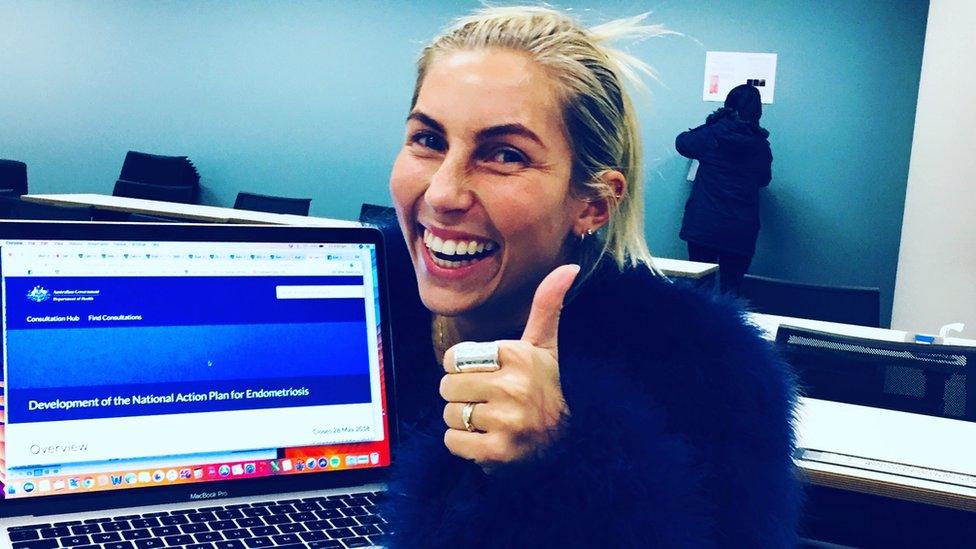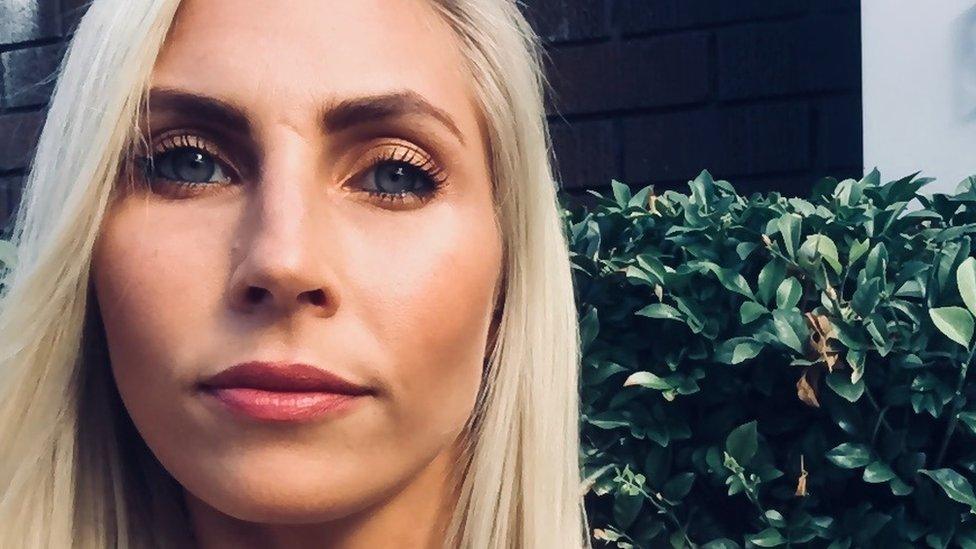Endometriosis: The pair who helped change Australia's conversation
- Published

Lesley (L) and Syl Freedman's petition for a medication drew a massive response
Australia recently launched its first "national action plan" targeting endometriosis. It followed the advocacy of many - not least a mother and daughter who used viral success to fuel a wider conversation, writes Gary Nunn in Sydney.
Earlier this year, Sylvia Freedman received a message from a woman she'd never met disclosing something she found "bizarre, but lovely!"
The woman had decided to name her baby Sylvia, because without Sylvia's advocacy, she'd never have got pregnant.
Syl suffers from endometriosis. Endometriosis (endo) currently has no known cause and no cure. It can cause severe pelvic pain and infertility.
Back in 2013, Syl's university tutor, who also had endo, offered to mentor her through an honours thesis on coverage of endometriosis in the media.
Their web search for media mentions of endometriosis returned zero mentions of the disease in any major Australian media outlets over 10 years. The tutor withdrew her offer, saying Syl couldn't do a literature review with nothing to review.
It was a fresh blow after a decade of confusion, debilitating pain, missed classes, losing jobs and endless hours on the couch hugging a hot water bottle, wishing she lived inside a different body.
Lobbying a pharma giant
Today, Sylvia, 27, is having a good day. She's able to sit upright on a chair opposite me and her mum, Lesley at their home in Sydney.
In the past, endo often left her unable to sit up, walk or even do up her jeans. Syl feels much better now partly thanks to effective excision surgery, daily self-management and Visanne - a drug designed to treat endo.
This medication is now available in Australia because Lesley and Sylvia took on pharmaceutical giant Bayer - and won.

Syl Freedman is now on a committee advising the Australian government
Lesley discovered that Visanne was having success in treating endo-related pain overseas, but Bayer would not bring it to Australia and New Zealand. "The marketing manager said I'd need to convince them there's a market for it here," she says.
Lesley started emailing her friends, but Syl thought there had to be a quicker way. She shared her story on Change.org, asking people to sign their petition targeting Bayer. The signatures would prove the need.
In total, they got 74,064 signers. Though the medication does not work for everyone, the pair were thrilled. Lesley wrote to supporters online: "Together, we've changed the mind of one of the world's biggest pharmaceutical companies."
From there they founded their own not-for-profit, EndoActive, which raises awareness, provides evidence-based information and advocates on behalf of the 700,000 women and girls with endo in Australia.
They convened Australia's first patient-centred endometriosis conference in 2015. "Women were in tears before they even walked through the doors, relieved they were finally being taken seriously," Lesley says. "Many women are not believed or told painful periods are normal."
Me and my endometriosis: 12 women share their stories
This awareness, along with work by others, helped bring about Australia's first National Action Plan for Endometriosis, external, launched last month.
"[Endo] is a silent epidemic, hidden due to stigma, misunderstanding, and society's easy dismissal of the importance and severity of pain in women," says Dr Susan Evans, a gynaecologist who is chair of the Pelvic Pain Foundation of Australia.
"Syl and Lesley have presented the story of girls and women in pain in a way that Australians appreciate, understand, and relate to. They've built on the work by women, advocates and consumers over many years to dramatically raise the profile of the condition."
'Insane' toll
It's estimated that one in 10 women have endo. It occurs when tissue similar to the womb lining grows outside it in other parts of the body (from reproductive organs up to the brain), in some cases strangling and gluing together other organs, causing excruciating pain.
It takes, on average, seven to 12 years to get diagnosed. Symptoms vary but can be devastating: many experience crippling pelvic pain, 30% have fertility problems, and 66% experience pain during sex.
Syl would often turn up to work then vomit violently straight away. She was constantly fatigued. Two surgeries took months to recover from.
"Endo symptoms are so weird and so random you feel like you're going insane," she says. "I still get anxious that people think I'm faking it."
The problem is, endo is an invisible illness. "The other day I had conjunctivitis" Syl says. "Everyone was saying 'you poor thing'. I thought, this is nothing! If only endo was this obvious."

Syl says she was left feeling desperate after receiving poor medical advice
Women have had to face such challenges in the diagnosis and treatment of endo, that Health Minister Greg Hunt made a national apology in December to recognise the pain and problems they've encountered in receiving adequate medical advice and treatment.
"Hearing that was so moving," Syl says.
Mr Hunt recently made a A$4.7m (£2.7m; $3.4m) commitment to the National Action Plan for Endometriosis and Syl now sits on the steering committee. Their first meeting will have many action points but debunking myths is high on Syl's list.
"Like so many women, I was told by a doctor that getting pregnant would help my pain," she says. "I was 21, in agony and without a partner. I asked my best friend, who's gay, if he'd consider having a baby with me. Mum considered recruiting her friend's son. I'd never even met him. That's how desperate we were.
"Now we know pregnancy isn't a cure. We need to re-educate doctors as well as patients."
Dr Evans says: "Throughout the world, endometriosis and pelvic pain are under-recognised, under-researched, under-managed and under-supported. There's vast unmet human need in this area and change has been slow."